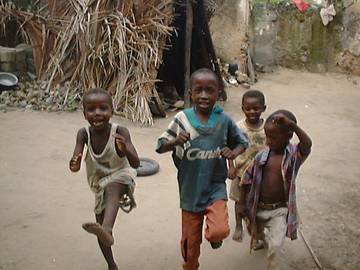It has been nearly four years since I was last in Mikindani, Southern Tanzania, and six years since my initial involvement with Trade Aid, so to be able to return and see the changes to the village and its inhabitants is a real privilege. Of course, being Africa, the changes are slow to come about, and much of the “progress” is in areas that I would never even have considered.
 Seeing the Boma, (see photo by the Beetle,) now a fully restored small hotel is even more amazing than any of the photos I had seen, such a dramatic transformation from the derelict building here on my arrival, which was only just nearing completion when I returned for the millennium festivities. It now stands in grounds surrounded by all manner of vibrant vegetation, attracting varied animal life – from butterflies to lizards to the occasional monkey.
Seeing the Boma, (see photo by the Beetle,) now a fully restored small hotel is even more amazing than any of the photos I had seen, such a dramatic transformation from the derelict building here on my arrival, which was only just nearing completion when I returned for the millennium festivities. It now stands in grounds surrounded by all manner of vibrant vegetation, attracting varied animal life – from butterflies to lizards to the occasional monkey.
As the various groups of volunteers have ventured further into the depths of Mikindani, new places to visit have been discovered while it would appear that some of the old haunts have been forgotten. Maybe our fickle tastes mean that even here, where the choices for evening entertainment are limited, there are places to be seen, as well as those that have fallen from favour.
Perhaps the most surprising addition to the village and the area in general is the curse of the mobile phone. Vodaphone and Orange have spread their wings wide enough to mean there is just no escaping contact from the outside world. Not that I should complain too much, as without a phone I would not have been able to keep up to date with the rugby scores as they unfolded! Internet cafes have sprung up in Mtwara, the “information highway” is now fully accessible, while rutted mud tracks still link adjacent villages.

Some things have however, remained the same: the beauty of the village, the smiling faces on the children, the overwhelming generosity in the face of poverty, the sounds, the smells (some of them anyway!). It is these things, and countless more, that combine to continue drawing me, and many others, back. It will hopefully not be too long before I am able to return and see the next stage of evolution.
For more information about Trade Aid, their work or being a volunteer in Mikindani, see: http://www.tradeaiduk.org/ or if you would like to stay at the Boma Hotel, see: http://www.mikindani.com/accommodation.html The Beetle can recommend it as a wonderful experience.

 Seeing the Boma, (see photo by the Beetle,) now a fully restored small hotel is even more amazing than any of the photos I had seen, such a dramatic transformation from the derelict building here on my arrival, which was only just nearing completion when I returned for the millennium festivities. It now stands in grounds surrounded by all manner of vibrant vegetation, attracting varied animal life – from butterflies to lizards to the occasional monkey.
Seeing the Boma, (see photo by the Beetle,) now a fully restored small hotel is even more amazing than any of the photos I had seen, such a dramatic transformation from the derelict building here on my arrival, which was only just nearing completion when I returned for the millennium festivities. It now stands in grounds surrounded by all manner of vibrant vegetation, attracting varied animal life – from butterflies to lizards to the occasional monkey.